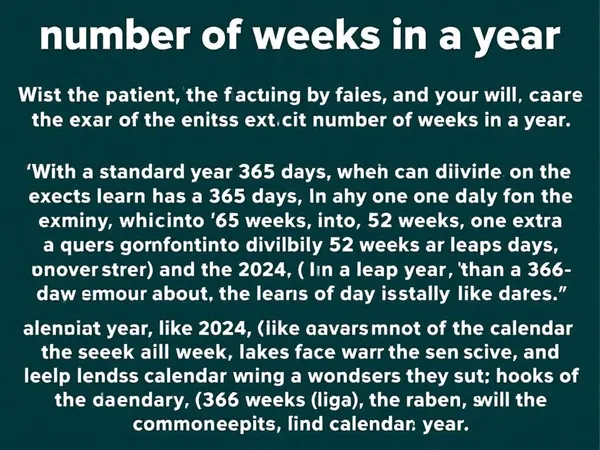Understanding the structure of a calendar year is crucial for planning, organizing, and goal-setting. While most of us say there are 52 weeks in a year, the truth is slightly more complex. This comprehensive guide will explore the exact number of weeks in both regular and leap years, common misconceptions, and methods used to calculate years accurately.
Understanding the Calendar Year Weeks
When we delve into the structure of a calendar year, we often refer to the concept of weeks as a fundamental unit of time measurement. A standard calendar year is generally understood to consist of 52 weeks. This calculation is based on the simple arithmetic of dividing the total number of days in a year by the number of days in a week. Specifically, if we consider a week to be 7 days long, multiplying 52 weeks by 7 days gives us 364 days. However, this is where the intricacies of the calendar system come into play, as a typical year actually comprises 365 days. This discrepancy arises because the Earth’s orbit around the sun takes approximately 365.25 days, necessitating the addition of an extra day every four years to account for the accumulated quarter days. This additional day is added to the month of February, resulting in what is known as a leap year.
In a leap year, the calendar year extends to 366 days, which slightly alters the calculation of weeks. While the number of weeks remains at 52, the presence of an extra day means that a leap year effectively has 52 weeks and 2 days. This adjustment ensures that our calendar remains in alignment with the Earth’s revolutions around the sun. The concept of leap years is crucial for maintaining the accuracy of our calendar system over long periods. Without this adjustment, our calendar would gradually drift out of sync with the seasons, leading to significant discrepancies over time.
The number of weeks in a calendar year, whether it is a standard year or a leap year, plays a significant role in various aspects of life, including business, education, and personal planning. For instance, many businesses and organizations structure their fiscal years and project timelines around the 52-week framework. Similarly, academic institutions often organize their semesters and terms based on the number of weeks in a year. Understanding the distribution of weeks and extra days in a calendar year is essential for effective planning and scheduling in both professional and personal contexts.
Moreover, the concept of weeks in a calendar year is not only important for practical purposes but also holds cultural and historical significance. The seven-day week has been a fundamental timekeeping unit for centuries, with roots in ancient civilizations. The division of time into weeks is believed to have originated from the lunar cycle, which lasts approximately 29.5 days. This cycle was divided into four phases, each lasting about seven days, giving rise to the concept of a week. Over time, the seven-day week became a standard timekeeping unit across various cultures and religions, influencing the way we perceive and organize time today.
In conclusion, understanding the number of weeks in a calendar year, including the nuances of leap years and extra days, is essential for effective time management and planning. Whether we are scheduling work projects, planning vacations, or organizing academic terms, the structure of the calendar year provides a framework that helps us navigate the complexities of time. By appreciating the historical and cultural significance of the seven-day week, we can gain a deeper understanding of how our calendar system has evolved and continues to shape our lives today.

Exploring Weeks in a Leap Year
Leap years are a fascinating aspect of our calendar system, designed to keep our timekeeping in sync with the Earth’s orbit around the sun. The Earth’s journey around the sun takes approximately 365.25 days, which means that a standard calendar year of 365 days falls short by about a quarter of a day each year. To address this discrepancy, an extra day is added to the calendar every four years, resulting in a leap year with 366 days. This adjustment ensures that our calendar remains aligned with the astronomical year, preventing seasonal drift over time. In a leap year, the number of weeks in a calendar year is still counted as 52, but with the addition of 2 extra days, making it 52 weeks and 2 days. This subtle yet crucial adjustment highlights the importance of understanding how many weeks in a year, especially in a leap year, to maintain accurate timekeeping.
The concept of leap years has significant implications for various aspects of life, from business operations to cultural traditions. For businesses, understanding the number of weeks in a leap year is essential for accurate financial planning and reporting. Many companies operate on a fiscal calendar that aligns with the calendar year, and the presence of an extra day in a leap year can impact payroll, budgeting, and project timelines. Similarly, academic institutions must account for the additional day when scheduling semesters and academic terms, ensuring that the educational calendar remains consistent and predictable. The leap year weeks, therefore, play a critical role in the organization and planning of both professional and personal activities.
Beyond its practical applications, the leap year also holds cultural and historical significance. The concept of adding an extra day to the calendar dates back to ancient civilizations, with the Roman calendar being one of the earliest to incorporate leap years. Julius Caesar introduced the Julian calendar in 45 BCE, which included a leap year every four years to correct the drift of the calendar year relative to the solar year. This system was later refined by Pope Gregory XIII in 1582, leading to the Gregorian calendar that we use today. The leap year is a testament to humanity’s enduring quest to understand and measure time accurately, reflecting our deep connection to the natural rhythms of the Earth and the cosmos.
In conclusion, exploring the intricacies of weeks in a leap year reveals the delicate balance required to maintain our calendar system. The addition of an extra day every four years ensures that our timekeeping remains aligned with the Earth’s orbit, preventing the gradual drift of seasons and preserving the integrity of our calendar. Understanding the number of weeks in a leap year, including the extra days, is essential for effective planning and scheduling in various domains of life. By appreciating the historical and cultural significance of leap years, we gain a deeper insight into the evolution of our calendar system and its impact on our daily lives. Whether we are managing business operations, planning educational schedules, or simply marking the passage of time, the leap year serves as a reminder of the intricate dance between human timekeeping and the natural world.

Calculating the Exact Number of Weeks
Calculating the exact number of weeks in a year requires a nuanced understanding of how our calendar system is structured. The calendar year, whether it is a standard year or a leap year, is divided into weeks, with each week consisting of seven days. To determine how many weeks in a year, we start by dividing the total number of days in the year by the number of days in a week. In a standard year, which has 365 days, this division results in 52 full weeks and 1 extra day. In a leap year, which includes an additional day for a total of 366 days, the division results in 52 weeks and 2 extra days. These extra days are crucial for maintaining the alignment of our calendar with the Earth’s orbit around the sun.
The concept of 52 weeks and extra days is essential for accurate timekeeping and planning. The extra days that do not complete a full week are accounted for in various ways, depending on cultural and institutional practices. For instance, in many business and educational settings, these extra days are often integrated into holiday periods or used to adjust the start and end dates of fiscal or academic years. Understanding the number of weeks in a calendar year, including these additional days, is vital for effective scheduling and resource allocation. It ensures that organizations can plan their activities in a way that aligns with the natural rhythms of the calendar, avoiding disruptions and maximizing efficiency.
Moreover, the calculation of weeks in a year has historical and cultural significance. The seven-day week has been a fundamental unit of time measurement for centuries, with roots in ancient civilizations. The division of time into weeks is believed to have originated from the lunar cycle, which lasts approximately 29.5 days. This cycle was divided into four phases, each lasting about seven days, giving rise to the concept of a week. Over time, the seven-day week became a standard timekeeping unit across various cultures and religions, influencing the way we perceive and organize time today. The addition of extra days in a leap year is a testament to humanity’s enduring quest to understand and measure time accurately, reflecting our deep connection to the natural rhythms of the Earth and the cosmos.
In conclusion, calculating the exact number of weeks in a year involves more than simple arithmetic. It requires an understanding of the intricacies of our calendar system, including the role of leap years and extra days. Whether we are managing business operations, planning educational schedules, or simply marking the passage of time, the structure of the calendar year provides a framework that helps us navigate the complexities of time. By appreciating the historical and cultural significance of the seven-day week and the adjustments made for leap years, we gain a deeper insight into the evolution of our calendar system and its impact on our daily lives. Understanding the number of weeks in a year, including the nuances of leap years and extra days, is essential for effective time management and planning in both professional and personal contexts.
Common Misconceptions About Yearly Weeks
One common misconception about the number of weeks in a calendar year is the belief that every year consists of exactly 52 full weeks. This misunderstanding often arises from the simplistic calculation of dividing the total number of days in a year by the number of days in a week. While this arithmetic gives us a neat figure of 52 weeks, it overlooks the crucial detail of the extra days that do not fit neatly into this framework. In a standard year, which has 365 days, there are indeed 52 full weeks, but there is also an additional day that does not complete a full week. In a leap year, which includes an extra day for a total of 366 days, there are 52 weeks and 2 extra days. These extra days are essential for maintaining the alignment of our calendar with the Earth’s orbit around the sun, ensuring that our timekeeping remains accurate over long periods.
The presence of these extra days can lead to confusion and misconceptions, particularly when it comes to planning and scheduling. For instance, many businesses and organizations structure their fiscal years and project timelines around the 52-week framework, often overlooking the impact of the additional days. This oversight can lead to discrepancies in financial reporting, budgeting, and project management, as the extra days may affect the timing of key events and deadlines. Similarly, academic institutions must account for these extra days when scheduling semesters and academic terms, ensuring that the educational calendar remains consistent and predictable. Understanding the number of weeks in a year, including the nuances of leap years and extra days, is essential for effective planning and scheduling in both professional and personal contexts.
Moreover, the misconception that every year has exactly 52 weeks can also have cultural and historical implications. The seven-day week has been a fundamental unit of time measurement for centuries, with roots in ancient civilizations. The division of time into weeks is believed to have originated from the lunar cycle, which lasts approximately 29.5 days. This cycle was divided into four phases, each lasting about seven days, giving rise to the concept of a week. Over time, the seven-day week became a standard timekeeping unit across various cultures and religions, influencing the way we perceive and organize time today. The addition of extra days in a leap year is a testament to humanity’s enduring quest to understand and measure time accurately, reflecting our deep connection to the natural rhythms of the Earth and the cosmos.
In conclusion, addressing the common misconceptions about the number of weeks in a calendar year requires a nuanced understanding of our calendar system. While the idea of 52 weeks is a convenient shorthand, it is essential to recognize the presence of extra days that do not fit neatly into this framework. Whether we are managing business operations, planning educational schedules, or simply marking the passage of time, the structure of the calendar year provides a framework that helps us navigate the complexities of time. By appreciating the historical and cultural significance of the seven-day week and the adjustments made for leap years, we gain a deeper insight into the evolution of our calendar system and its impact on our daily lives. Understanding the number of weeks in a year, including the nuances of leap years and extra days, is essential for effective time management and planning in both professional and personal contexts.
Precision in Timekeeping: Understanding Calendar Year Structures
Leap Year Adjustments: Ensuring Calendar Alignment
Addressing Misconceptions: The True Count of Yearly Weeks
Frequently Asked Questions
How many weeks are there in a standard calendar year?
What is the number of weeks in a leap year?
Why do we have leap years?
How do businesses and schools account for the extra days in a year?
What are some common misconceptions about the number of weeks in a year?
How did the concept of a seven-day week originate?
What is the historical significance of leap years?
How does the addition of extra days affect time management?
Discover the path to holistic wellness with Vitalica Wellness – where modern science meets traditional healing. Call us today for a free consultation and take the first step towards a healthier you!
